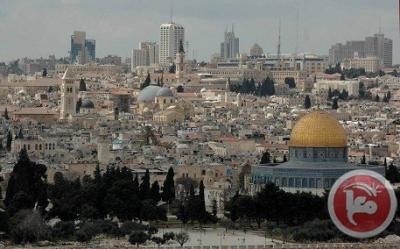
Palestinians charge land-grab in Jerusalem greenbelt plan

An Israeli government plan to create a greenbelt around Jerusalem is fueling opposition among Palestinians and their supporters. Mayor Nir Barkat's hopes the plan, which focuses on archeological preservation, will boost tourism in Jerusalem, but critics say the parks amount to a land grab that consolidates Israel's grip on occupied East Jerusalem. "People say, 'It's just a park,' but these parks change totally the political scope of Jerusalem and have a direct impact on the lives of Palestinians," says Hagit Ofran, who monitors Jewish settlements for Peace Now. Efrat Cohen Bar, an architect with the progressive Israeli urban planning group Bimkom, which recently conducted a study of national parks in East Jerusalem and evirons, terms them "green settlements"—which serve to keep Palestinians off the land while expanding Israeli control.
The national parks now being established would link and expand areas under Jewish control, from the Old City through the heart of East Jerusalem to the West Bank settlement of Maale Adumim. A key link in the chain is Mount Scopus Slopes National Park—to be built on what residents say is the only land available for the expansion of the crowded Palestinian neighborhood of Isawiya. "This park will choke the people of Isawiya into a given area and prevent them from having a natural life," said Isawiya leader Darwish Darwish. "It prevents any development and progress." Isawiya's 15,000 residents currently live on 150 acres—an area smaller than that of the planned park. Some 112.5 acres owned by Isawiya residents and 75 acres owned by residents of nearby al-Tur are slated to become part of the park without any compensation to the owners, who would technically retain ownership under an "easement" type arrangement.
Leading the national park drive is Evyatar Cohen, head of the Jerusalem district in the National Parks Authority and a former staffer for Elad—a hardline settler group. The NPA, however, dismisses charges that the park is driven by any political motive. "The National Parks Authority is not a political body and its only interest is preserving nature and landscape values," said spokeswoman Osnat Eitan.
The Jerusalem municipality, which is strongly backing the project, says the area of the park has "high archaeological importance," with sites dating back two millenniums. But Emek Shaveh, a group of dovish Israeli archaeologists, disputes that, charging that archaeology is being misused to boost Israeli claims in the struggle for East Jerusalem. In a recent report, Emek Shaveh wrote that when archaeological finds have been made in areas earmarked for Jewish neighborhoods, development proceeded and there was no declaration of the areas as a national park.
Emek Shaveh and Peace Now say the real imperative behind the park is to create Israeli contiguity between the Old City and a contested area known as E1 on the outskirts of Maale Adumim, connecting the two via the Tsurim Valley park. "There is no justification to have a park there," said Ofran. "Its only purpose is to connect the Holy Basin and E1."
The E1 area is slated for a new settlement for about 14,500 settlers, although work was halted in 2004 after US objections. The E1 situation was highlighted in a recent European Union report finding strong indications—including the impending forced removal of 2,300 Bedouin Arabs from the area—that the plan is moving ahead. The EU Heads of Mission Report on East Jerusalem concluded that the EU should consider legislation to prevent or discourage companies and organizations in member states from doing business that supports Israeli settlements
But Jerusalem city councilor Yakir Segev, dismissed this analysis of the greenbelt plan. "There is no conspiracy here," Segev says. "And this [park] is not being done because the people being impacted are Arabs." (CSM, Jan. 20; The Guardian, Jan. 17)

